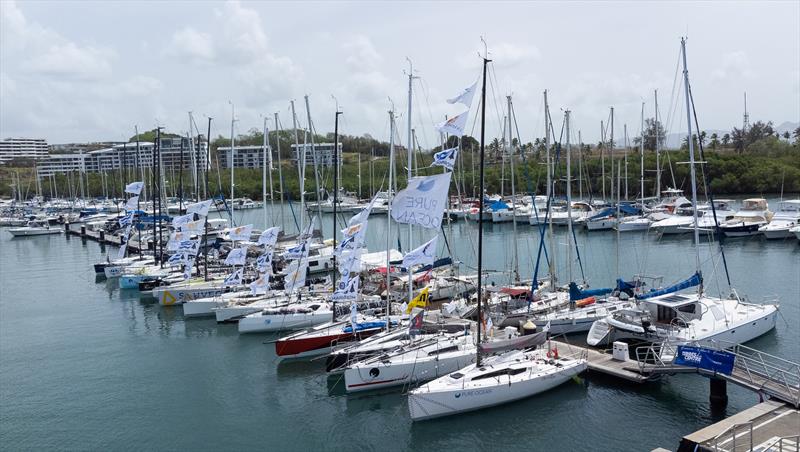
Lessons learned from second edition of Cap-Martinique
by Cap Martinique 14 May 2024 13:30 BST

The Marina de l'Etang Z'Abricots, near Fort-de-France, accommodated the entire fleet © Cap-Martinique
The curtain falls on this second edition of the Cap-Martinique today with the arrival of Marine and Sébastien Péjoan, the 51st and final competitor to cross the finish in this second edition.
Thibaut Derville and Jean-Philippe Cau, co-organisers, make the most of this opportunity to take stock of a race that is set to become a classic.
How did the finishes play out?
Emotions ran high. For amateurs, crossing the Atlantic single-handed or double-handed is a massive challenge and they were all transformed in Fort-de-France at the finish. What is immensely gratifying with this transatlantic is seeing that the sailors all come out to welcome one another into port. Even Robert Jacobson, despite retiring from the race in the Azores, came out to Martinique and witnessed nearly all the finishes. South African Adrian Kuttel retired in Madeira and he insisted on completing his transatlantic passage outside the ranking. This blend of good sportsmanship and conviviality perfectly sums up the spirit of the Cap-Martinique.
What is the sporting analysis of this Cap-Martinique?
It's incredible! If we look at the winners in the various categories, we can see that every shoreline in France is represented, from north to south and east to west, and even the inland waters. It's interesting because races seldom gather together competitors from all over France and it just goes to show that the level is actually very similar.
Amaury Dumortier and Geoffrey Thiriez from Lille took line honours, whilst Gérard Quenot and Bertrand Daniels from La Rochelle, took the win in the overall ranking in corrected time. In the solo category, the first across the line was Ludovic Gérard from Marseille and Régis Vian took the solo win in corrected time. Régis comes from Le Mans and trains in La Trinité-sur-Mer. All that is indicative of the fact that there are some very good sailors on all of France's stretches of water and beyond. We have also seen that the race appeals to overseas amateurs too with the participation of sailors from Belgium, Holland as well as South Africa and the United States. Indeed, Americans Justin and Christina Wolfe sailed a fantastic race since they finished the course in 7th place in elapsed time.
What is the feeling among the racers?
All the sailors are unanimous: the Cap-Martinique is the toughest and most demanding of the amateur races. It's a long, merciless course, which requires exceptional stamina. The competition is also extremely fierce as the top players are all here. After 20 days of racing and 3,800 miles, we saw the boats making the finish in the bay of Fort-de-France in close contact. It's a unique experience.
What elements will you carry with you from this second edition?
Everyone has the loss of Philippe Benoiton in their thoughts. Today, we know that he died on his boat, very likely struck by his boom, but other incidents occurred and had a better outcome. There is always an element of risk at sea but each sailor has a responsibility to reduce them as much as possible.
There were some very young crews this year. Is that a surprise?
We know that youngsters love adventure so it's not a complete surprise, but it is good news. We often talk about renewing generations and we can see that the next generation is really stepping up to the plate. What is surprising though is how well they are progressing. This is especially true of Ivan Lecat and Gwendal de la Rivière, as well as François Ropartz and Vianney d'Aboville. When they signed up about two years ago, they were virtually beginners, but they've managed to raise their game to make the start in good shape. Their attendance during the training sessions was exemplary and they managed to sail a magnificent race. This race served as an apprenticeship. In the space of two years, they've switched category. They've gone from being enthusiastic sailors to experienced offshore racers. It will be a great source of inspiration for fellow sailors.
On the other side of the population pyramid, we have 76-year-old Jacques Amédéo. His performance commands admiration too and shows that our sport can be practiced at any age with just as much enjoyment.
Are you seeing a change in competitor profiles?
What we're seeing is that the standard is increasingly high. The Cap-Martinique is geared towards good sailors, but above all those who want to become good sailors. It's important to pay tribute to the work done by the training centres in La Trinité-sur-Mer and La Rochelle. There is now a preparation standard, which involves sailing for 50 days a year, within a well supervised group. It's a demanding format for amateurs, who have very busy lives, but it enables you to take the start of this transatlantic race in good shape.
Will there be a third edition?
Of course! This second edition has made it possible to get the Cap-Martinique even more established. We're lucky to have enthusiastic skippers as well as some precious partners, ranging from companies to regional bodies and authorities. This year we switched marina for the finish, which is a real step in the right direction. The Marina de l'Etang Z'abricots, just 15 minutes from Fort-de-France, boasts incredible infrastructure. Indeed, we'd like to thank all the team who did a fabulous job accommodating this fleet.